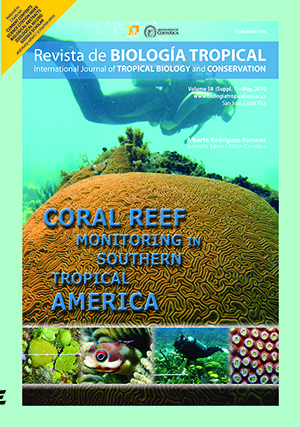Abstract
Significant coral reef decline has been observed in Colombia during the last three decades. However, due to the lack of monitoring activities, most of the information about health and changes was fragmentary or inadequate. To develop an expanded nation-wide reef-monitoring program, in 1998 INVEMAR (Instituto de Investigaciones Marinas y Costeras: “Colombian Institute of Marine and Coastal Research”) designed and implemented SIMAC (Sistema Nacional de Monitoreo de Arrecifes Coralinos en Colombia: “National Monitoring System of Coral Reefs in Colombia”) with the participation of other institutions. By the end of 2003 the SIMAC network reached more than twice its initial size, covering ten reef areas (seven in the Caribbean and three in the Pacific), 63 reef sites and 263 permanent transects. SIMAC monitoring continued without interruption until 2008 and should persist in the long-term. The SIMAC has a large database and consists basically of water quality measurements (temperature, salinity, turbidity) and a yearly estimation of benthic reef cover, coral disease prevalence, gorgonian density, abundance of important mobile invertebrates, fish diversity and abundance of important fish species. A methods manual is available in the internet. Data and results of SIMAC have been widely circulated through a summary report published annually since 2000 for the Colombian environmental agencies and the general public, as well as numerous national and international scientific papers and presentations at meetings. SIMAC information has contributed to support regional and global reef monitoring networks and databases (i.e. CARICOMP, GCRMN, ReefBase).##plugins.facebook.comentarios##

This work is licensed under a Creative Commons Attribution 4.0 International License.
Copyright (c) 2010 Revista de Biología Tropical






